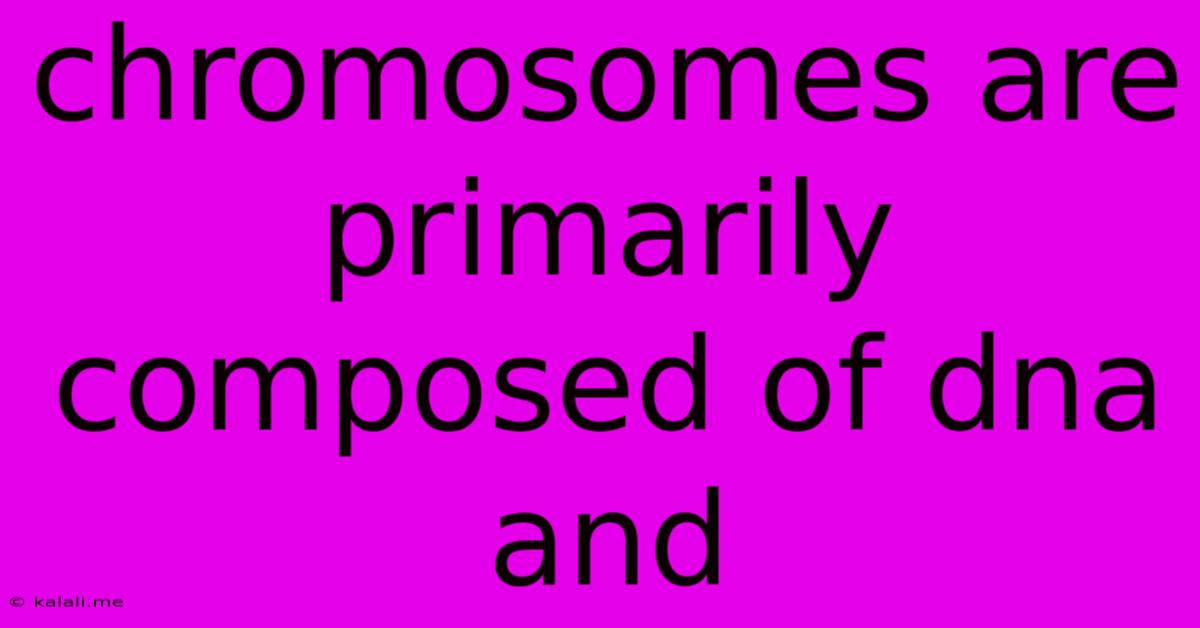Chromosomes Are Primarily Composed Of Dna And
Kalali
Jun 15, 2025 · 3 min read

Table of Contents
Chromosomes: Primarily Composed of DNA and Proteins – A Deep Dive
Meta Description: Chromosomes, the fundamental units of heredity, are not just DNA. This article delves into the intricate composition of chromosomes, exploring their structure, function, and the crucial role of proteins in their organization and regulation.
Chromosomes are the fundamental building blocks of heredity, carrying the genetic information that defines every living organism. While it's commonly known that chromosomes are composed primarily of DNA, the reality is far more nuanced. This article will explore the intricate structure of chromosomes, focusing on the interplay between DNA and proteins and their vital roles in cellular processes.
The Double Helix and Beyond: The DNA Component
Deoxyribonucleic acid (DNA) is the undisputed star of the chromosome. This iconic double helix molecule holds the genetic code, a sequence of nucleotides (adenine, guanine, cytosine, and thymine) that dictate the synthesis of proteins. These proteins are the workhorses of the cell, carrying out countless functions that govern everything from metabolism to cell division. The specific sequence of nucleotides within a DNA molecule constitutes a gene, a unit of heredity responsible for a particular trait. The sheer length of DNA within a single chromosome is astounding, requiring sophisticated packaging mechanisms to fit within the microscopic confines of the nucleus.
The Architectural Scaffold: The Role of Proteins
While DNA holds the genetic blueprint, it cannot function alone. Chromosomes are not simply strands of naked DNA; they are complex structures intricately organized with the help of a variety of proteins. These proteins are crucial for several key aspects of chromosome function:
-
DNA Packaging: The immense length of DNA requires compact packaging to fit into the nucleus. Histone proteins are the primary players in this process, forming nucleosomes – structural units where DNA wraps around histone octamers. This packaging is further condensed into chromatin fibers, ultimately forming the characteristic X-shaped chromosomes visible during cell division. This intricate packaging is highly regulated, controlling gene expression and accessibility.
-
DNA Replication and Repair: Specialized proteins are essential for DNA replication, ensuring accurate duplication of the genetic material during cell division. Other proteins are involved in DNA repair, correcting errors and preventing mutations that could have deleterious consequences.
-
Gene Regulation: Proteins play a critical role in gene regulation, controlling which genes are expressed (activated) and which are silenced. This intricate control mechanism ensures that genes are expressed only when and where needed, contributing to cellular differentiation and adaptation. Transcription factors, a class of proteins, bind to specific DNA sequences, influencing the initiation of transcription, the first step in protein synthesis.
-
Chromosome Segregation: During cell division (mitosis and meiosis), the accurate segregation of chromosomes is paramount. Proteins called kinetochores attach to the chromosomes and facilitate their movement to opposite poles of the dividing cell, ensuring each daughter cell receives a complete set of chromosomes. Errors in this process can lead to chromosomal abnormalities with serious consequences.
Beyond the Basics: Chromosome Structure and Variations
The structure of chromosomes is not uniform across all organisms. While the basic principles of DNA and protein organization remain consistent, variations exist in the size, shape, and number of chromosomes among different species. Furthermore, specific chromosomal regions, such as telomeres (protective caps at the ends of chromosomes) and centromeres (constricted regions involved in chromosome segregation), exhibit unique structural features and functions. Understanding these variations is essential for comprehending the diversity of life and the evolution of genetic systems.
Conclusion: A Symphony of DNA and Protein
In conclusion, chromosomes are not simply strands of DNA but highly organized structures resulting from the intricate interplay between DNA and a diverse array of proteins. This complex architecture is crucial for DNA packaging, replication, repair, gene regulation, and accurate chromosome segregation. The precise organization and regulation of chromosomes are essential for the proper functioning of cells and the transmission of genetic information from one generation to the next. Further research continues to unravel the complexities of this fundamental unit of heredity, revealing new insights into the mechanisms that govern life itself.
Latest Posts
Latest Posts
-
Is The Square Root Of 45 A Rational Number
Jun 15, 2025
-
Which Of The Following Statements About Cells Is Correct
Jun 15, 2025
-
The Part Of Earth Where Life Exists
Jun 15, 2025
-
Which One Of The Following Is An Intangible Fixed Asset
Jun 15, 2025
-
Distinguish Between Sampling And Non Sampling Errors
Jun 15, 2025
Related Post
Thank you for visiting our website which covers about Chromosomes Are Primarily Composed Of Dna And . We hope the information provided has been useful to you. Feel free to contact us if you have any questions or need further assistance. See you next time and don't miss to bookmark.